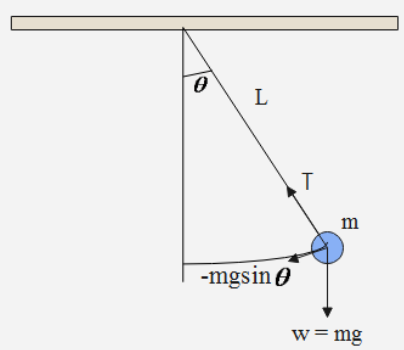
State the laws of a simple pendulum.
Answer
560.1k+ views
Hint: We know that a simple pendulum is represented by a mass of no size attached to a string with no mass. There are four laws of a simple pendulum. Each law gives information on how the physical quantity of the simple pendulum varies with each other.
Formula used:
$T\alpha \sqrt L $
Complete step-by-step solution
there are four laws of a simple pendulum, these are as following:
1). The first law of the simple pendulum states that the period of oscillation of a simple pendulum of constant length is independent of its amplitude provided the amplitude is small.
2). The second law of the simple pendulum states that the period of oscillation of a simple pendulum having constant length is independent of the size, shape, mass, and material of the bob, provided it is not very light, like a cork.
3). Now the last law of the simple pendulum states that the time period of oscillation of a simple pendulum is directly proportional to the square root of the length of the pendulum, for a given place.
$ \Rightarrow \dfrac{{\sqrt L }}{T} = const.$
$\dfrac{L}{{{T^2}}} = const.$
Squaring both sides we get:
$\dfrac{L}{{{T^2}}} = const.$
4). We can say that, based on the laws of the simple pendulum mentioned above, the time period of a simple pendulum. We can write the relation between the time period ‘T’ of a pendulum and acceleration due to gravity ‘g’ as T is inversely proportional to the square root of g. This relation between the time and the acceleration due to gravity is referred to as the fourth law of the simple pendulum.
Additional information: We will now discuss the basic definition of a simple pendulum and a compound pendulum.
A simple pendulum is represented by a mass of no size attached to a string with no mass. A compound pendulum represents a real object that is swinging about a point other than its center of gravity.

Since we know that the two pendulums differ from each other, one difference between them is that the simple pendulum is the only physical property that affects its period is its length. The mass of the object does not affect the period whereas, in a compound pendulum the object’s mass and how that mass is distributed are important in determining the period.
Note: We should remember that a simple pendulum is different from a compound pendulum. The time period and other factors like its length affect the simple pendulum. We should remember how these physical quantities vary in a simple pendulum.
Formula used:
$T\alpha \sqrt L $
Complete step-by-step solution
there are four laws of a simple pendulum, these are as following:
1). The first law of the simple pendulum states that the period of oscillation of a simple pendulum of constant length is independent of its amplitude provided the amplitude is small.
2). The second law of the simple pendulum states that the period of oscillation of a simple pendulum having constant length is independent of the size, shape, mass, and material of the bob, provided it is not very light, like a cork.
3). Now the last law of the simple pendulum states that the time period of oscillation of a simple pendulum is directly proportional to the square root of the length of the pendulum, for a given place.
$ \Rightarrow \dfrac{{\sqrt L }}{T} = const.$
$\dfrac{L}{{{T^2}}} = const.$
Squaring both sides we get:
$\dfrac{L}{{{T^2}}} = const.$
4). We can say that, based on the laws of the simple pendulum mentioned above, the time period of a simple pendulum. We can write the relation between the time period ‘T’ of a pendulum and acceleration due to gravity ‘g’ as T is inversely proportional to the square root of g. This relation between the time and the acceleration due to gravity is referred to as the fourth law of the simple pendulum.
Additional information: We will now discuss the basic definition of a simple pendulum and a compound pendulum.
A simple pendulum is represented by a mass of no size attached to a string with no mass. A compound pendulum represents a real object that is swinging about a point other than its center of gravity.

Since we know that the two pendulums differ from each other, one difference between them is that the simple pendulum is the only physical property that affects its period is its length. The mass of the object does not affect the period whereas, in a compound pendulum the object’s mass and how that mass is distributed are important in determining the period.
Note: We should remember that a simple pendulum is different from a compound pendulum. The time period and other factors like its length affect the simple pendulum. We should remember how these physical quantities vary in a simple pendulum.
Recently Updated Pages
Master Class 11 Chemistry: Engaging Questions & Answers for Success

Why are manures considered better than fertilizers class 11 biology CBSE

Find the coordinates of the midpoint of the line segment class 11 maths CBSE

Distinguish between static friction limiting friction class 11 physics CBSE

The Chairman of the constituent Assembly was A Jawaharlal class 11 social science CBSE

The first National Commission on Labour NCL submitted class 11 social science CBSE

Trending doubts
What is meant by exothermic and endothermic reactions class 11 chemistry CBSE

What are Quantum numbers Explain the quantum number class 11 chemistry CBSE

What is periodicity class 11 chemistry CBSE

Explain zero factorial class 11 maths CBSE

What is a periderm How does periderm formation take class 11 biology CBSE

Mention the basic forces in nature class 11 physics CBSE




